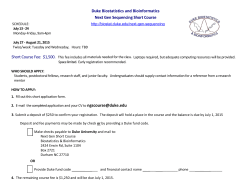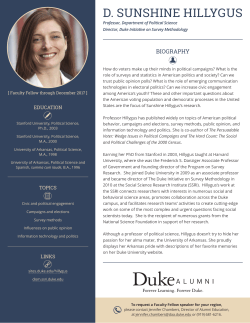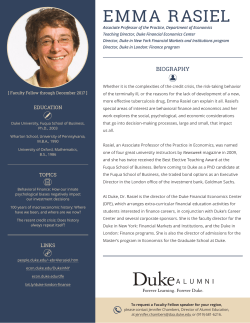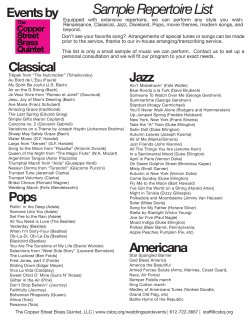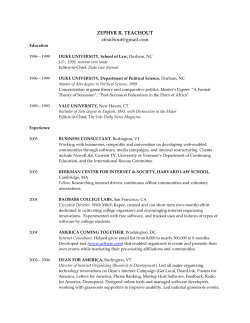
WORLD OF WONDER - Sterling DiSanto & Associates
08 VALUATION 1Q 2015 FRONT LINES Stories and insights from the field WORLD OF WONDER Appraising Doris Duke’s 2,700-acre estate was like going back in time to another world By RUSSELL K. STERLING, MAI H illsborough, New Jersey, is just 35 miles west of Manhattan, and like many New York City suburbs, it offers a variety of single-family houses, condos and apartments, shops, parks and great schools. The average lot size for a house there is less than one acre. But that’s not counting one outlier: the 2,700-acre property known as The Duke Estate, home of the late heiress Doris Duke. Who was Doris Duke? She was the only child of James “Buck” Buchanan Duke, a founder of the American Tobacco Company and Duke Power Company and benefactor of Duke University. Doris was only 12 years old when her father died in 1925, and she inherited the bulk of his estate (at the time, it was estimated at $100 million) and became known as “the richest girl in the world.” Miss Duke (as she was known to her employees) had other properties around the world but considered the Hillsborough estate her home. She simply called it “Duke Farms.” Here she enjoyed her interests in Asian art, horticulture, environmental conservation, wildlife and animal welfare. Miss Duke was an extremely private person and a celebrity in a region not known for its celebrities. Miles of stone walls separated her property from the rest of the world, which added to the property’s mystique. When I got the call to appraise the property, I realized I was about to learn more than anyone else about Miss Duke and her property. It was both exciting and a little intimidating. After Miss Duke died in 1993, a large trust company was retained to handle her estate. They were well aware of the public curiosity and scrutiny surrounding Miss Duke’s holdings, as well as possible challenges to her will. They needed an appraisal of Duke Farms for the estate filing, one that could withstand the most thorough legal scrutiny. I was recommended for the assignment because of my knowledge of the local market and experience with Russell K. Sterling, MAI, is a partner in the New Jersey firm of Sterling DiSanto & Associates, specializing in complex valuation assignments and litigation valuation. He served on the Appraisal Institute’s Board of Directors from 2008-12, as president of AI’s Metro New Jersey Chapter in 2005 and on numerous AI committees. large estate properties, as well as my litigation valuation experience. This assignment started just like any other — with due diligence and an inspection of the property — although this one took a lot more time. Entering the property was like going into another world and back in time 80 years. This was a country village. Dozens of small, Tudor-style cottages for the employees lined narrow, meandering country roads. Along the mile-long driveway to the mansion were lakes, gardens, fountains and statuary. I needed a few minutes to take in the enormity of the house. It didn’t have any particular style but most closely resembled a Tudor with some architectural elements borrowed from French country houses. The house originally began as a large, older farmhouse that was dramatically altered and expanded by Buck Duke in the early 1900s. The design of the house was attributed to Kendall, Taylor and Stevens, a prominent Boston architectural firm of the day. The mansion, simply referred to by Duke employees as the “The Residence,” was more than 50,000 square feet and was one of the largest in the region. The main house contained 21 rooms, including nine bedrooms and nine full bathrooms. Attached to the www.appraisalinstitute.org main residence was the “Hollywood Wing,” a huge structure containing an indoor tennis court and swimming pool, a game room and a theater. What struck me first was that the house was immaculate but had never been modernized. Everything in the house was as it had been in the 1920s. Bathroom fixtures and finishes and the commercial-style kitchen were immaculately maintained 1920s vintage. Heating was provided by an antiquated, single-zone hot water system. There was no air conditioning. According to employees, Miss Duke wanted to maintain the house as it had been when she was a child, the way it was when her father was alive. In addition to the mansion, the property contained more than 100 other structures. The most significant included a magnificent stone “coach barn” with clock tower that contained a garage, Asian art museum and stables for Miss Duke’s prized camels. There also was an elaborate stone and timber barn that served as the centerpiece of Miss Duke’s award-winning dairy farm. (Its high-quality milk received significant acclaim.) Most of the other buildings were houses for Miss Duke’s 50 to 60 employees. A water treatment plant built in the early 1900s along the nearby Raritan River supplied water to the estate’s man-made reservoirs. Law Olmsted firm (creator of New York’s Central Park), and Horatio Buckenham, who worked with Olmsted on many projects. The mansion was designed by the renowned architect Horace Trumbauer. Around 1910, the landscaping, bridges, reservoirs, roads and mansion foundation were completed. Construction on the mansion mysteriously was halted in the early 1900s, and everything was left as it was; remains of the foundation are still visible. Make No Little Plans Completing the appraisal assignment posed many challenges, especially when it came to highest and best use. My analysis indicated that there were different highest and best uses for different sections of the property. Some of the land bordered the Raritan River and was prone to frequent flooding, precluding any development. Other areas had low-density residential zoning and were ideal for New Jersey’s farmland preservation program. (Yes — there is farmland in New Jersey!) My staff and I measured every building on the property, and floorplans were drawn, square footage was calculated and condition and functional adequacy was noted for each. Not surprisingly, I had many questions about the property, but with the secretive Miss Duke gone, no single person had a grasp of the history of the property and buildings, so I spent many hours in a small office on the grounds poring over documents, old photos, site plans and construction plans. There I uncovered quite a surprise: the enormous residence was meant to be temporary. Buck Duke had planned for a spectacular mansion to be built in the center of the property, similar to the “cottages” built in Newport, Rhode Island, by the Vanderbilt’s and other prominent families of the Gilded Age. Duke had hired the best architects of the day. The grounds were designed by James Leal Greenleaf, a member of the Frederick demolished to make way for development. Homes that survived frequently were converted to other uses, such as country clubs, private schools and colleges, corporate conference centers and religious facilities. I considered all these possibilities, and my opinion was that continued use as a private residence was the least viable option. Miss Duke left her estate to the Doris Duke Charitable Foundation, which serves as an endowment for charitable foundations J.B. Duke transformed more than 2,000 acres of farmland and woodlots into the extraordinary landscape that became Duke Farms. He excavated nine lakes, built 18 miles of roadway and constructed or remodeled 100 structures, including the coach barn (above left) and The Residence, a 50,000-square-foot, 21-room mansion (above right). Wildlife and Environmental Protection The marketability of the mansion was the most challenging due to its enormous size, age and functional obsolescence. I met with several experts in marketing estate properties and conducted research on the history and use of other large estates in the region, many of which had fallen into disrepair due to the enormous amounts of required upkeep. A few had been renovated, but most were that aligned with her lifelong interests in wildlife and animal welfare and environmental preservation, and these foundations and their trustees had the ultimate say over the future use of the property. (I have consulted with those foundations over the years, and was told my appraisal became their “bible” since it contained the first and only inventory of every single structure on the massive property.) They believed that Miss Duke wanted her property to be used as a showcase for wildlife and environmental protection. In 2003, approximately 200 acres of Duke Farms was opened for guided tours, but then in May 2012, nearly 1,000 acres were opened to the public for environmental education and research programs and recreational activities. Now visitors can tour more of the property and experience the same sense of awe I did upon seeing the grounds for the first time. 09
© Copyright 2025

